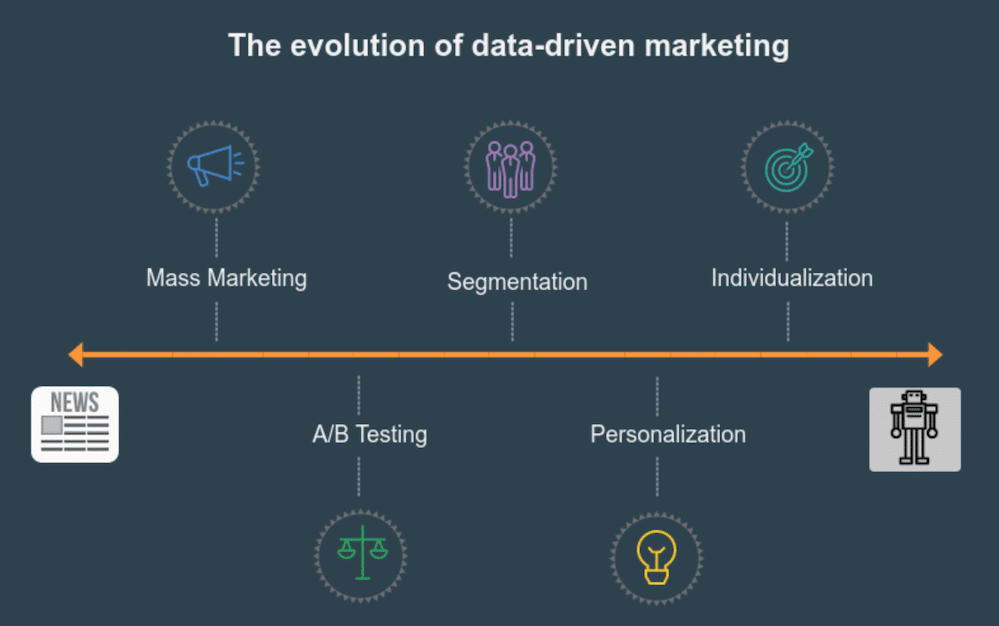Sophisticated advances in tech now enable you to change your relationship with each consumer. Specifically offline, via email, unique in its product selection, for each consumer. In some ways, marketers have always had some sort of strategy to react to the needs and wants of their consumers. Previously this information was best collected through segmentation and many other metrics. But more and more it is being appreciated that the ROI typically enjoyed there is woefully lacking in comparison to what’s available now.
But how do we most effectively use the tools available to us now? What do some of these things mean? What is personalisation? And how does individualisation tie in?
For marketing purposes only, the semantics today dictate that personalisation is a technique that uses basic customer data to tailor messages to each audience at once. In real life however if something is personal to you, then it is individual, but alas that is now the dictate. Established email software companies, whose technology is used to mass marketing to consumers, foresaw the problem early and usurped their right to it, to ensure to continued sale of their now “old technology”. Individualisation speaks directly to each individual within those groups and therefore requires a much richer data set.
Personalised marketing typically uses general data such as past purchases or user logins. That data is then used to segment audiences into groups. Instead of communicating with someone based on their segment, individualisation communicates directly with each person one-on-one. With the advent of AI technology, and in particular, the benefits afforded by machine learning, your messaging can be shaped by data that is unique to them.
Customers have always expected brick-and-mortar businesses to cater to their needs. Today, many technologies can analyse data online and customers are starting to expect online businesses to do the same. So, simple personalisation based on general data isn’t enough anymore.
Online businesses need to accept that simple personalisation is outdated. In the past, customers would expect nothing more than having their first name in the welcome line of an email. But today, nearly everyone has some version of simple personalisation strategies in place. Basic personalisation at that level is now an expectation, not an innovation.

Personalisation vs. Individualisation – the marketing distinction types
Mass Marketing: Expensive, untargeted mass marketing messages used to tell one story to a mass audience. Although mass marketing targets a large group of people at once, it fails to segment audiences in any detailed way.
Once newspapers came around, a company was able to sell its products directly to a mass audience. While greatly reduced in scale and price, mass marketing campaigns still occur in printed magazines, billboards, and even on TV.
A/B Testing: Running an A/B test is a tactic almost as old as the printing press. A/B testing occurs when marketers compare two versions of a marketing asset with only one varying element. A/B Testing makes data-driven marketing decisions based on test results that reveal user behaviour and tendencies.
The biggest difficulty with A/B Testing is the complexity of reacting to test results. Testing tools have improved with technology. However, the best results come from a continuous process that sometimes requires constant manual oversight.
Many multivariate tests fail to deliver significant benefits. The more variants used, the more time-consuming and frustrating the tests can become. Regardless, A/B testing was the first step that marketers took towards modern-day segmentation.
Segmentation: Segmentation uses basic information to bucket prospects into similar groups based on similar interests, locations, or needs. Through testing, marketers learned that different messages worked with different people. Segmentation allows marketers to create different designs and layouts for different segments, or to scale interfaces to suit different devices.
While this technique created a better customer experience, this technique also requires personal information. Unfortunately, modern marketers have amassed a scary amount of personal information as a consequence. While the individual customer benefits from a better message or product, that same customer no longer enjoys their privacy.
Personalisation: Companies can now shape their messaging through personalisation with a very clear picture of the consumer. Personalised experiences can range from personalised messages on a website (“Hi Ellie, welcome back”) to completely altered images and button colours.
A personalised journey can easily come across as creepy if executed in the wrong way. If done right, personalisation will offer a visitor a more humanised experience. Online personalised greetings welcome website visitors like the store owner would do at your local clothing boutique. Personalised product recommendations find things you want just like the boutique owner showing you that cute new shirt.
Traditionally, businesses could only greet you by name or recommend a shirt when you came into the store in person. Now, online businesses have a lot of the same information available through your past purchases or abandoned shopping carts.
Individualisation: While certain kinds of personalisation can be done with a limited amount of data, individualisation is a more complex variety. To truly individualise, you must be speaking to your user as a segment of one. Online individualisation is only really possible by combining a massive amount of data.
The best way to speak directly to each consumer is to leverage two separate data streams. Firstly, continue to personalise based on what you know about that user. Secondly, collect as much of the users’s behaviour as you can.
The more data you can access, the closer you can get to true individualisation. However, all of this data would be too much for a human to collect and use at any given moment. Fortunately, we’re doing business in an age of advanced machine learning and AI systems, which brings these marketing dreams firmly into the realm of reality.
The data that drives individualised marketing
Individualised marketing is the most effective strategy in which marketers can reach individuals and relate to them in a timely and personalised way. An individualised marketing strategy should include a recommendation engine that recommends the most relevant products to each individual.
The engine should look for hints and cues as to what each customer’s goals and needs are. If you know what the customer is looking for, you will be able to show them products or content on an individual level.
A note about privacy
The methods to achieve individualization (hyper-personalisation), and personalisation in general, are sometimes a bit invasive. Increasingly, massive amounts of personal data are collected and used to guide marketing strategies. We only recommend you rely on 1st party data only, where you can ensure the permissions from your customers first hand.
Your consumers appreciate the need to concede to some of their data in exchange for personalised content, and ecommerce retailers can improve the user experience using personal data ethically and transparently. If trust is gained, consumers feel more comfortable sharing more about themselves. If your customers trust you, you can truly connect your brand to each individual.
Conclusion
You might be wondering whether any of this is relevant to you, and in a world clambering for your attention it is easy to appreciate why. The bottom line however is the ROI. It is easy to see why the closer you get to your customers, the more they appreciate and spend with you. This has never been truer than today. The sooner you furnish your digital strategy with an individualisation solution the sooner the big bucks can be enjoyed.





